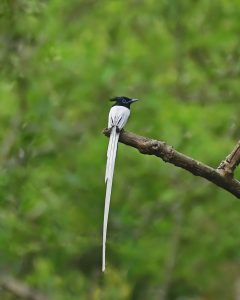A Bird Straight Out of a Fairytale
With its ethereal tail streaming like silk in the wind, the Indian Paradise Flycatcher is one of the most enchanting birds of the Indian subcontinent. Mysterious and dazzling, especially when the adult male dons his long white tail, this bird is a living emblem of the wilderness — elegant, elusive, and utterly unforgettable.
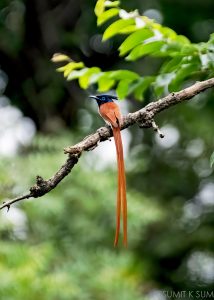
Whether you’re a seasoned birder or a casual nature lover, the first sight of this bird feels like a magical encounter. This article will take you on a deep dive into everything you need to know about the Indian Paradise Flycatcher (IPFC), from identification and habitat to breeding behavior and folklore.
🪶 Quick Facts about Indian Paradise Flycatchers
|
Trait |
Detail |
| Scientific Name | Terpsiphone Paradisi |
| Hindi Name | दूधराज या सुल्ताना बुलबुल |
| Average Lifespan | 5–8 years |
| Migration | Partial migrant |
| State Bird | Madhya Pradesh |
| Tail Length (Males) | Up to 30 cm! |
| Conservation Status | Least Concern (IUCN) |
Identification of IPFC: Beauty with Wings
🕊️ How to Recognize an Indian Paradise Flycatcher
- Size: Around 19–22 cm for females and non-breeding males; up to 40 cm or more for long-tailed breeding males
- Male (breeding plumage):
- Crested black glossy head
- White or rufous body
- Spectacular tail streamers (can be over twice the body length!)
- Female:
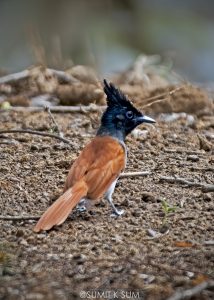
-
- Rufous-brown body
- Dark grey or blackish head with a small crest
- Shorter tail
- Rufous-brown body
| 🔄 Did You Know? The same male bird can change color from rufous to white as it matures — a rare trait among birds! |
Distribution of Indian Paradise Flycatchers
The Indian Paradise Flycatcher is widely distributed across India and parts of Asia.
| Countries | India, Nepal, Bangladesh, Sri Lanka, Pakistan, Myanmar, and parts of Central Asia |
| In India | Found in deciduous forests, gardens, wooded groves, and mangroves from the Himalayan foothills to southern India |
| Altitudinal range | From sea level up to 3000 meters in the Himalayas during summer |
🧭 Migration Fact: They are partial migrants — many northern populations migrate southward in winter, while southern residents remain year-round.
Habitat of IPFC: Forest Shadows and Garden Groves
These birds thrive in:
| Moist deciduous forests |
| Riparian woodlands |
| Mango orchards and rural gardens |
| Urban parks with dense tree cover |

They prefer places with tall trees, shaded understory, and insect-rich environments. Males are often seen darting through dense foliage, chasing flies mid-air in spectacular aerial displays.
🌿 Related Read: Purple Sunbird – The Shimmering Pollinator — another bird that thrives in tree-rich, flower-laden habitats.
Feeding Behaviour in Indian Paradise Flycatchers
🍽️ What Does an IPFC Eat?
The Indian Paradise Flycatcher is an insectivore, feeding almost exclusively on flying insects.
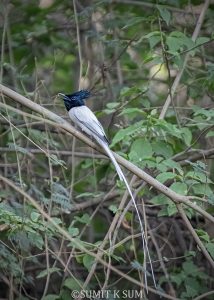
| Moths |
| Dragonflies |
| Termites (especially during swarms) |
| Flies and gnats |
| Small beetles and bugs |
🎯 Hunting Style of The Indian Paradise Flycatcher
- Uses “sally-gleaning” technique: darts out from a perch to catch insects mid-flight
- Returns to the same or nearby perch
- Can hover briefly while grabbing insects off leaves or bark
This bird is incredibly agile, flitting between trees with fluid, dance-like motions.
Breeding and Nesting of The Indian Paradise Flycatcher
🪺 Breeding Season:
- Mainly May to July (varies by region)
- Some southern populations may breed earlier (March–April)
🧱 Nesting Details: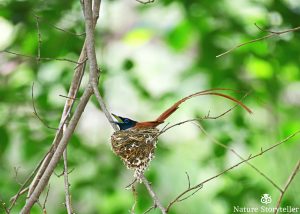
*Image for information only. It is highly recommended to not post nesting images otherwise.
- Nests are cup-shaped, built from grass, bark, cobwebs, and rootlets
- Usually placed on a fork of a slender branch, often overhanging water
- Nest is beautifully camouflaged, often resembling part of the tree
🐣 Clutch and Parenting:
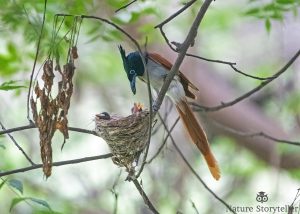
*Image for information only. It is highly recommended to not post nesting images otherwise.
- 2–4 eggs per clutch
- Both male and female participate in incubation and feeding
- Chicks fledge in about 14–16 days
🪵 Compare With: Brown-headed Barbet – The Loud Knocker of Indian Gardens — another cavity-nesting bird with a unique breeding strategy.
Behaviour of The Indian Paradise Flycatcher – Shy Yet Spectacular
- Often solitary or seen in pairs during breeding
- Frequently joins mixed-species foraging flocks
- Prefers quiet, undisturbed forests
- Territorial during nesting season, especially males
- Emits soft calls — a sharp “chee-chee” or “tsree-tsree” — often heard before the bird is seen
Subspecies and Plumage Variation of The Indian Paradise Flycatcher
The Indian Paradise Flycatcher has three main color morphs among males:
- Rufous Morph: Rusty chestnut body and long tail
- White Morph: White body with elongated white tail streamers
- Intermediate Morph: Mixed or transitioning colors
Though once classified into different species (e.g., Asian Paradise Flycatcher), recent taxonomy consolidates them as plumage variations of the same species.
Folklore and Cultural Significance in India
In many parts of India, the Indian Paradise Flycatcher is considered a symbol of freedom and beauty.
📚 In Local Lore:
- In northern India, it’s called Swargiya Pakshi (heavenly bird) due to its tail resembling celestial ribbons
- In Bengali folklore, it’s sometimes associated with monsoon spirits arriving with fresh rains
- In tribal cultures of Chhattisgarh, sighting one during sowing season is seen as an omen of prosperity
This bird also features in poetry and spiritual writings, revered for its almost surreal beauty.
Conservation Status of The Indian Paradise Flycatcher
As per the IUCN Red List, the Indian Paradise Flycatcher is listed as Least Concern. However, its habitat is under constant pressure.
⚠️ Threats Include:
- Deforestation of native woodlands
- Loss of old nesting trees
- Urban expansion without green cover
- Pesticide use affecting insect populations
✅ Conservation Actions You Can Take:
- Preserve large trees in gardens and parks
- Avoid using chemical pesticides
- Encourage native forest planting
- Spread awareness through bird walks and schools
📚 Also Read: Common Kingfisher – The River Jewel — another small bird vulnerable to habitat change.
White-Morph vs Rufous-Morph Male Indian Paradise Flycatchers
| Feature | White Morph Male | Rufous Morph Male |
| Plumage Color | Pure white body with glossy black head and crest | Rich chestnut (rufous) back, wings, and tail with black head and crest |
| Tail Streamers | Very long, white ribbon-like central tail feathers (can exceed 30 cm) | Also long, but the streamers are rufous-colored |
| Age Factor | Generally older, fully mature males | Younger adult males, often early in breeding maturity |
| Geographical Distribution | More common in northern and central India | Often found in southern and western India but overlaps occur |
| Seasonal Change? | White morph is usually permanent, not seasonal | Some rufous males transition into white morph with age |
🎯 Key Takeaways
- ✅ Same species, just different color morphs — not subspecies or different birds.
- ⚪ The white morph is typically the final, most mature plumage of older males.
- 🧡 Rufous morph males may eventually molt into white morphs over the years.
- 👀 Both are equally stunning and perform the same courtship rituals and behaviors.
🔍 Fun Fact: You might even see white and rufous morphs nesting in the same forest, competing for mates or food!
🕊️ Do Male Indian Paradise Flycatchers Shed Their Tails?
Yes, they do.
The long, ribbon-like tail streamers that make adult breeding males so spectacular are not permanent — they are molted (shed) annually, usually after the breeding season.
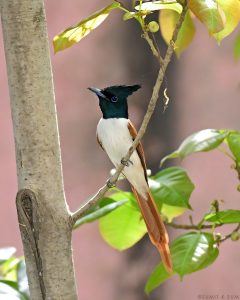
🔄 Molting Process and Tail Shedding
- Molting Season: Typically occurs after the breeding season, around late summer to early autumn.
- During molt:
- They shed their long central tail feathers
- Shorter tail feathers regrow first
- New tail streamers grow over the following months, reaching full length before the next breeding cycle
- The molting process helps maintain feather health, as old feathers become worn, frayed, or damaged from flight, mating displays, and nesting duties.
🔍 Observation Tip: If you spot a male with a black head and white or rufous body but no tail streamers, it’s likely he’s in molt or post-breeding condition — not a different species!
🔄 Seasonal Appearance Shift
Because of tail molt:
- The same male can look dramatically different depending on the time of year.
- Post-breeding males may resemble females or younger males, leading to confusion in identification.
🎯 Key Insight for Birders
When documenting or identifying an Indian Paradise Flycatcher:
- Always consider the time of year
- A streamer-less male may still be a fully mature adult
- Tail length is not always a reliable indicator of age or breeding status during the non-breeding season
Suggested Read: Sarus Crane
Migration Pattern of Indian Paradise Flycatchers in India
🐦 1. Partially Migratory Behavior
- The species shows a mix of resident and migratory populations.
- Migration behavior largely depends on:
- Geographical location
- Climate and habitat conditions
- Breeding season dynamics
🌍 2. Migration Within India: Region-wise Breakdown
🏔️ Northern India & Himalayan Foothills
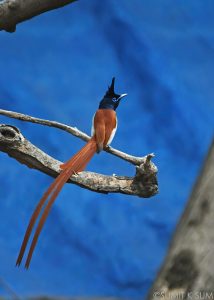
- Summer Visitors (April–September):
- Breed in states like Uttarakhand, Himachal Pradesh, Jammu & Kashmir, Punjab, Haryana, and Uttar Pradesh.
- Arrive in spring (March/April).
- Winter Migration:
- Move southward to central and peninsular India during colder months (October–February).
🌳 Central India
- Includes Madhya Pradesh, Chhattisgarh, parts of Maharashtra.
- Acts as both breeding and wintering ground.
- Some birds stay year-round, while others pass through during migration.
🌴 Southern India
- Resident populations are found in Kerala, Tamil Nadu, Karnataka, Andhra Pradesh, and Telangana.
- These populations typically do not migrate, though some individuals may show short-range movement based on food availability.
🐦 Northeast India
- Present during the summer breeding season.
- Likely to migrate west or south in winter, although exact routes are less documented.
🧭 3. International Migration
While Indian Paradise Flycatchers are mostly within India, some migratory individuals from northern India and Central Asia:
- Travel southward to Sri Lanka during winter.
- Occasionally recorded in Maldives, Andaman & Nicobar Islands, and Bangladesh.
- Some rare vagrants even reach Thailand and Myanmar.
📅 Seasonal Timeline (General)
| Season | Region | Movement |
| Spring (Mar–Apr) | North, foothills | Arrive to breed |
| Summer (May–Jul) | Across India | Breeding active |
| Monsoon (Aug–Sep) | Pan-India | Nesting continues; some post-breeding dispersal |
| Autumn (Oct–Nov) | North → South | Begin southward migration |
| Winter (Dec–Feb) | South, Central India | Non-breeding season |
🔍 Quick Facts: Migration
- Migratory Type: Partial migrant
- Longest movements: From North India to Sri Lanka
- Drivers: Temperature drop, food scarcity, breeding need
- Visible Migration Peaks: March–April (northward) and October–November (southward)
🎯 How This Helps Birders and Photographers
- Best time to spot breeding males: April to July in Himalayan foothills and central India
- Best place to see streamers: During courtship season (summer) in deciduous forests
- Winter sightings: Tail-less or short-tailed males in southern forests or protected areas like Silent Valley (Kerala) or Nagarhole (Karnataka)
Also Read
| Spotted Owlet – The Tiny Night Guardian |
| Indian Peafowl – The Pride of India |
| Indian Pitta – The Melodious Gem |
| Get your favourite Indian Paradise Flycatcher photograph framed for your wall – Request Now @+91-9540178459 |

